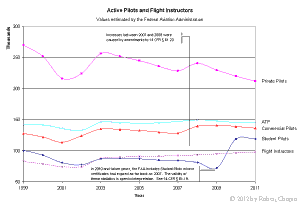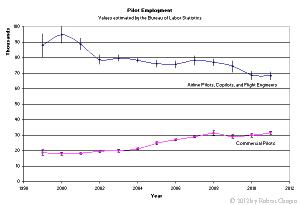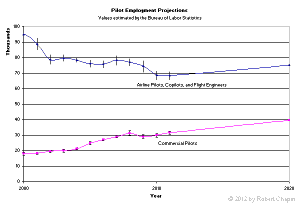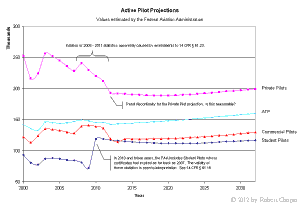
The aviation industry is famous for its booms and busts. While all industries are subjected to business cycles, aviation is unique for its cries of a “pilot shortage” looming or existing during each boom. Airlines leverage this perception of a “shortage” to lobby for relaxed hiring rules, while flight schools use this in sales pitches to convince students they are in high demand.
This often leaves pilots wondering: Is there really a shortage? How long will a shortage last?
In my opinion, this concept of a pilot shortage, real or not, is disseminated by the media. It seems somewhat implausible that the same problem is occurring again and again for the same reasons, with the same forecasts, in different political and economic circumstances.
Consider, for example, a 1989 article in The New York Times that describes an imminent shortage that was caused by:
- “An aging corps of pilots.”
- “A decline in the number of new students.”
- “A lack of growth in the airlines’ customary supply of aviators from the military.”
Compare that to a 2012 article in USA Today that describes a pilot shortage that will be caused by:
- “A wave of pilot retirements at U.S. airlines.”
- “Tougher qualification standards for new pilots.”
- “The pool of military-trained pilots that airlines have relied upon in the past has largely dried up.”
Well have I got a news story for you! Pilots always get older, students never want to pay for anything, and World War II ended a long time ago.
For the sake of presenting pertinent facts about this topic, I’ve gathered up several small piles of numbers. The first, graphed above, is the number of pilots estimated to have active certificates in the United States for the past 12 years. This information comes from the U.S. Civil Airmen Statistics compiled by the FAA. Below are my observations:
The number of Private Pilots has declined 17% since 2003. This is the only fact offered by the FAA that would truly support the existence of any type of pilot shortage. On the other hand, there are over 280,000 commercial-certified and airline-certified pilots. Those second two groups are holding steady. One cannot infer how many of the 280,000 pilots are looking for flying jobs or getting regular flight time. Instead, how many of them are already employed?

This graph is based on information compiled by the Bureau of Labor Statistics. It shows there are 100,000 pilots employed, with an error of about +/- 4,000 pilots. This number has declined significantly from 113,000 +/- 7,000 pilots in 2000. Once again, the raw statistics do not indicate a shortage. The number of pilots employed has contracted relative to the number of “active” pilots available.
But the past is the past, and what is interesting here is what happens when one asks if there will be a pilot shortage in the future? Both the FAA and the Bureau of Labor Statistics compile projections of future aviation activity.

The employment projection adds 15,000 U.S. pilot jobs over 9 years. As a point of comparison, Boeing’s 2012 Current Market Outlook adds 69,000 jobs to all of North America over 19 years. Both projections indicate a reversal of the current downward trend in the number of airline pilots in the U.S.
Will there be enough new pilots to fill those new jobs?

The FAA projects only 2,200 more ATPs in 9 years. That is a potential problem because more of the airline positions will require ATP certification starting in 2013. Even though the total number of 148,100 projected ATPs appears to be more than adequate for the 75,300 projected airline jobs, there is definitely a projected trend of jobs growing faster than the pilot supply.
One thing that strikes me as being odd in the FAA projections is the strong trend reversals for both Private Pilots and Commercial Pilots. The projections show the downward trends continuing through 2012 and then changing to nearly flat after 2013 and 2014. Why would the downward trends not continue after 2012? I could find no answer to that question so far. The FAA only says this to support the projection for Private Pilots:
The number of private pilots is projected to grow at an average yearly rate of 0.1 percent over the forecast period to a total of 199,300 in 2032 from 194,441 in 2011.
To bring this topic home, I must explain my own opinions about pilot shortages. I am an optimist about the aviation industry, which is one of the main reasons why I’m in a 4-year flight degree program now. At the entry level, a pilot shortage really just means the regional airlines are going through a hiring cycle. It’s unrealistic to expect the American aviation market to actually run out of pilots. At the level of the major airlines, it is difficult for me to even imagine a shortage. The way the industry is set up, the majors should always be able to generate attrition from the regionals to fill any openings.
For further reading, I recommend the News21 Pilot Shortage article. Along with the New York Times and USA Today links above, these articles provide a great deal of insight into the global aviation industry, as well as many of the common opinions about pilot shortages in the United States.
19 responses to “Pilot Shortage: Just the Facts”
Rob – Nicely written. Good perspective. john
Interesting article, some good points there. Your final conclusion is that regional pilots will continue to flow to the majors without limit. Right now the regionals are paying new hires more than majors are, pay at regionals has moved up steadily while pay at majors has dropped over the past twenty+ years, they are getting closer. The regional airlines are businesses that will compete and pay more for resources as they get scarce, including pilots. The major airlines will have to compete for pilots, and they aren’t looking desireable right now.
Another point is that half the US domestic flying is done by “regionals” now, the majors other than Southwest rely almost entirely on regional feed to/from their hubs. If the regionals lose pilots as forecast by the Regional Airline Association, the mainlines will lose feed and not be able to justify all their seats. If both the regional and mainline airlines have to shrink for lack of pilots, that is a shortage, a serious one. It will have an effect on the economy and needs to be taken seriously now.
I did come across the RAA press release from July in researching my article. I feel there are two things to take away from it: #1 The date corresponds to the media frenzy that followed the release of Boeing’s outlook on July 11. Pilot shortage was a hot sound byte at the time, and I didn’t see the RAA bringing any new information to the topic. #2 The RAA press release says its president “cited FAA statistics showing a steady decline in the number of pilots.” Well, you can judge the FAA statistics (presented above) for yourself. Even if the overall number of pilots is declining, the number of ATPs is steady, and the FAA actually projects overall increases.
Is it possible the airlines would “shrink for lack of pilots?” When and if there is ever a genuine shortage in the U.S., then perhaps!
I agree with you completely, Robert. As stated, there has supposedly been a shortage of pilots since 1989. If anything, there may be a shortage in general aviation or lower aircraft ownership. But as far as the airlines go, I think they’ll reduce the number of flights and/or locations before hiring more pilots.
Again, there is not, never was, and never will be a shortage of pilots… There is, however, a shortage of pilots willing to rack up 120k+ of debt (60 for college, 60 for flight training) for a job that pays slave wages for the first 5 to 10 years. 1500 hour rule means you will be instructing for about 2 to 3 years (10 to 20k per year, BEFORE TAX), then IF you are lucky enough to get picked up by a regional, then another 2 years of making under 30k. I know some people that have been instructing for years with 2500+ TT. Why would they be doing that if they could have been hired a long time ago? Tells me that nobody worth it is hiring. First year pay at ANY airline should be 50k+. Now you need to instruct for a much longer time, so it’s not fair. Oh, and don’t tell me about your war stories walking up hill both ways to the hangar “Back in my day we needed 2000 TT to even get looked at by a regional! waa waa.” But it’s convenient how you fail to mention that you also got picked up by a major in less than 4 years. Now it takes 10+. Also you had the luxury of cheap gas and/or military training. (Military doesn’t train airplane pilots anymore, they only train drone pilots.)
I disagree. There are multiple variables that aren’t explored here. The baby boomers are undoubtedly aging, and to replace them hasn’t been such an easily attained process. The boomers are of a generation that birthed 3-5 children typically. The usual these days appears to be 1-3 children. That’s a loss of 2 kids per family. Not to mention the loss of both women and men working full time now, whereas the generation that’s aging typically only had the father working allowing for a larger family. Now knowing that, of course the baby boomers are still certified, they’re still alive. This is where the inflated numbers come from. Of course there are still all these pilots around, they’re retiring not dying.
As for the military, there are decreasing numbers. As anyone who follows the news knows, cuts in military spending have reduced the number of trained pilots. Combine this with less aircraft required to complete the same mission.
The third factor which has been dismissed several times, is the international aviation burst. You have China becoming a real presence in the aviation world, UAE, Dubai, Korea etc etc.
I think there is legitimate need for concern, but I don’t believe it’s as dramatic as everyone has made it out to be.
I thought your article was informative and well worth the read. From my experience as a pilot in the Air Force, I’ve seen many pilots in the Reserves and National Guard who work both as airline pilots and part time as military pilots. Many of them are furloughed pilots waiting to fly again. Quantifiable? As far as a military influx, take a look at Sequestration; the new standard of military funding and debt reduction. Little Rock AFB is getting rid of the C130H leaving the AF trying to find 150 different positions for pilots/retraining (This decision happened virtually overnight and shocked the C-130 community and I was almost in that boat). My guess is this will happen to other aircraft. B-52? The last 10 years have been busy for freight pilots, retirement is far away and likely to be cut to a 401K anyway. So if their are flying jobs to be had, I’d envision the AF losing pilots if their is a decent outlook for an airline job worth the pay.
I think you need to focus more attention on the number of commercial or higher pilots not employed in aviation. These are typically educated proffesionals that simply did the math! Why work an 18 hr duty day and get paid for 8 hrs for years with a good chance of having to start all over when your CEO takes a $100 mil bonus to ride the company into bankruptcy? Wouldn’t it be safer to work 8 hrs and get paid for 8? Better yet, 120 hrs a month instead of 70 or 80? On top of that there are infinately more stable positions in other industries!
Yes, there is a looming shortage of pilots. There has been since shortly after WWII. To be precise, there’s a shortage of people with good judgement willing to spend so much to get so little in such an unstable career. Add in the Chinese explosion and their draw from the regionals that US majors had planned on and US airlines may actually have to pay pilots a decent wage from year one, not just after year 15…
Shortage? There’s no shortage of pilots, just a shortage of airlines worth working for!
There is no pilot shortage. Never was nor will there ever be a pilot shortage. It’s a sales gimmick to sucker ppl into flight schools. Flight schools cannot compete with the military. If you want to fly & have a career the best training experience & hours accumulated will be in the military. No you don’t have to be a fighter pilot. They fly soilders & supplies too. And you get paid while they train you. In the civilian world you have to pay for training. Plan on about $100k+for ATP license. Then the next 10 yrs as a flight instructor making less than a cab driver. I went the civilian route. Make $20k as a flight instructor. I still owe $80k. I have a 2nd job landscaping. Am 40yrs old & landscaping is making me ill due to developing allergies. Spent 5 yrs crop dusting. Back when that didn’t pay anything. Some places now pay pretty decent for crop dusting but at first no pilot wants to be a crop duster. My friend who went the military route flew AC 130s in the military mostly. Got out after 10yrs & started flying for fed ex. He’s 40yrs old makes $170k no flight school debt and works about 4 days a wk. Think about it. You are an airline do you hire him or me? There are plenty of pilots for airline companies to choose from out of the military. Don’t believe the BS about pilot shortages. Simply put there is none. There are plenty of pilots. I bought into the flight school rhetoric” get your ATP in 2 yrs flight instruct for 2-3 yrs then fly for a major airline within 5 yrs making $100k working half a month.” yeah right. It never happened. It should be against the law to false advertise.
I’m 12 years into the professional pilot racket and I find all of this talk of a looming shortage interesting. I am yet to see it, its still really darn competitive out there for all of the jobs I want, but I think the shortage is probably already here for the regionals. Especially the lower-rung operations. I would like to see some better data but I do think there is more truth behind this latest talk of a shortage. The talk of how many new private and commercial pilots are being minted is an interesting metric but how is the FAA counting? Higher education is one of the United States biggest exports at the moment and it may be more even more true in aviation. How many of those FAA certified pilots are intended for domestic consumption vs. foreigners coming here to train and then leaving to go back to their home countries where they already have a nice job waiting for them in a Boeing or Airbus? I work as a RJ Captain and all of the new FO’s I fly with coming from an instructor background all say the same thing; “I was instructing Chinese kids” (or Indians, or Saudis, etc etc. you fill in the blank, but its never Americans anymore. I’ve been hearing the same thing since about 2006.)
I totally agree with your synopsis: “It’s unrealistic to expect the American aviation market to actually run out of pilots. At the level of the major airlines, it is difficult for me to even imagine a shortage. The way the industry is set up, the majors should always be able to generate attrition from the regionals to fill any openings.”
Yes, true, but this assessment fails to take into account that the distinction between mainline and regional is a false dichotomy, a myth that has been sold to government regulators and working professional pilots all for the purpose of labor arbitrage. If the regionals can’t find decent pilots to hire, then mainline hiring from their regional partners becomes ‘robbing Peter to pay Paul’ as my grandmother would say. The side of my aircraft says “United” and the passengers onboard my aircraft their tickets all say “United Airlines”. All of the revenue goes to United and United only pays my regional company what they feel like for the seats as long as the regional company can figure out a way to keep the operation going. When the regionals start canceling flights for a lack of personnel guess who it hurts? That’s right the mainline partner who’s passengers they carry. If the regionals really find themselves in a supply-demand crunch and have to start paying pilots a lot more than they do now the cost-saving benefits of maintaining the charade of a mainline airline and a fractured bunch of messy, squabbling ‘independent’ regional partner airlines will evaporate. When the labor arbitrage savings go away the remaining big three legacy carriers will probably start bringing the regional airlines back in-house to keep costs down and ensure steady and reliable operations.
Of course this is all predicated on nothing big happening in the next few years to change the game. Oil could hit $300 a barrel, our corrupt Congress could certify all 121 aircraft for operation with one ATP and a “safety pilot” who just works the radios and throws the gear, etc. The massive shortage is not here and as the industry is structured now Delta/United/American/Fed-Ex will probably always be able to choose from a vast pool of over-qualified applicants, but I can attest the regionals are feeling the pilot shortage at present because there’s not that many guys with 1500hrs and a ATP who want to sign on the dotted line for what they are offering. Word got out that being a regional pilot sucks. Too many people watching Frontline and Michael Moore movies I guess.
Things should get interesting
We still might need pilots for a while however this does not mean that it will translate into improved wages or working conditions for pilots.
Wildcards on the horizon like advances in automation and pilot factories being developed in the middle east and Asia are positioning themselves to flood the global market with cheap labor. The airlines provide a fairly homogeneous product. They only way to effectively compete is through having the lowest cost structure. In spite of pilot demand downward pressure will continue on wages.
There will be a shortage of first world pilots who are willing to work for the wages and conditions offered. Regionals and ultra low cost carriers will continue to take over the domestic market paying their employees ever less until the job really isn’t worth having at all.
The “pilots have no value” opinion is certainly the most pessimistic out there, and I consider it a straw man argument. Pilots are neither expensive relative to the costs of fuel and equipment nor expensive relative to the value they provide. The competitive trends are toward larger airplanes, fewer engines, better aerodynamics, and safe, smart management.
Hi!
Love your article. Do you have more current graphs that you could share?
What is the expected pilot & cabin attendant growth over the next 3 – 5 years?
I would appreciate any insight you can share with me.
~S
Hi Steffany, these are good questions. I may be inspired to make new graphs for a new article. 🙂 In a month or two, the 2013 data should be available, and that’s the best time for us to look.
No Pilot shortage eh… You give statistics on US domestic airlines, but have you done any research on International airlines? I have been conducting International pilot training in groups of between 15-20 Commercial pilots in 4 classes a year. Pilots are coming here at 18-24 years old to get their Instrument and Multis in C-172s and Seminoles or Senecas. I have been told by chief pilots from Airlines such as Air Thailand, Malaysia, Singapore, Syria, Egypt who tell me they are worried about the future getting quality pilots who aren’t glued to the FMC. (Take a look at the Aireaana crash at SFO recently. The Pilots had no idea how to land the aircraft by hand. That is what I am dealing with, pilots who have forgotten how to fly.
Do I think there will be a shortage–you bet. As the growing international airlines keep on growing at the pace they are and with their high starting pay, not only will there be a shortage, but they will draw US pilots away. I personally know 5 pilots in my class now flying for International airlines.
I was a Piper dealer in the 80’s when domestic production went from over 18,000 general aviation planes a year to less than 2,000 just one year later. Did you know that china has bought Textron (Cessna and Piper? I got my Private in a c-152 in 1974 and it cost me $2,300 now it is between $5-10,000. All of the airlines I talk to in getting potential pilots in strict regimented training programs are all concerned about finding good pilots who have Basic skills like unusual attitudes, recovery from death spirals, and knowing when to turn off the FMC and just fly the plane. Many of the crashes lately (and there are many no one hears about in Russia, southeast Asia, and southwest Asia.) when you find out the reason it would knock your parachute off–nearly two a week!
So yes I see a shortage not only in numbers but in quality.
I have a question for the group. With the wave of pilot retirements at U.S. airlines, are you aware of a commercial practice for knowledge/skill transfer? Is there a standard or an airline that has a Model for transferring knowledge/skill to ensure there is not a wide gap in available resources? Maybe a common framework around skills development for pilots?
The retiring pilots at the airlines are generally not the same people involved in flight instruction. With a wave of pilot retirements, there is no more or less knowledge gap, but a large demand for new pilots and flight instructors.
10 years ago our company wanted 6000 total time, couple thousand on jets over 55 tons. Cut the wages about 20-30% by jacking up overtime threshold and increasing flying to legal maximums, changed what was legal, did not count bunk time. Surprise! Needed to drop the minimums to find people. Dropped the heavy time requirement, took regional jet, then just Turboprop was ok, still not enough people now it is 1500 hours and an ATP. Wages have crawled back to maybe a bit less than 10 years ago, certainly less purchasing power with inflation. Way more sickness now with the maximum legal hours, night flights over multiple time zones.
Shortage? Yeah, a shortage of intelligent people who want to take huge debt load for an unstable job that will take years off your life.
Hi,
Friends i am in a deep confusion as to select Pilot line as my future career.I am currently in High School and i just can’t decide either to go for it or not because many of my friends tell me that that new pilots are no longer employed and that there is a high unemployment rate for fresh pilots.The fact it hurts the most is that i always wanted to be a pilot like i care about this job more than the money so please can anyone advice me to it..I’ll be thankful.
Regards